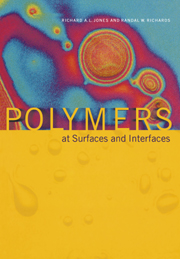Book contents
- Frontmatter
- Contents
- Preface
- 1 Introduction and overview
- 2 The surface of a simple polymer melt
- 3 Experimental techniques
- 4 Polymer/polymer interfaces
- 5 Adsorption and surface segregation from polymer solutions and mixtures
- 6 Tethered polymer chains in solutions and melts
- 7 Adhesion and the mechanical properties of polymer interfaces at the molecular level
- 8 Polymers spread at air/liquid interfaces
- Index
1 - Introduction and overview
Published online by Cambridge University Press: 19 January 2010
- Frontmatter
- Contents
- Preface
- 1 Introduction and overview
- 2 The surface of a simple polymer melt
- 3 Experimental techniques
- 4 Polymer/polymer interfaces
- 5 Adsorption and surface segregation from polymer solutions and mixtures
- 6 Tethered polymer chains in solutions and melts
- 7 Adhesion and the mechanical properties of polymer interfaces at the molecular level
- 8 Polymers spread at air/liquid interfaces
- Index
Summary
The study of the properties of any material must begin with the development of an understanding of its properties in the bulk state. However, pure, bulk phases are idealisations of the physicist rather than widely encountered realities; all around us we find complicated assemblies of materials mixed on an intimate, but not molecular, scale. It is an old truism that a human being is 70% water, but it would be just as accurate and probably more helpful to characterise ourselves as being almost all interface. What makes us different from 50 1 of water and a few kilograms of solid, much of it polymeric, is the fantastically intricate hierarchy of structures, from sub-cellular organelles of sub-micrometre size through cells up to organs of macroscopic size, all these structures being demarcated by interfaces of one kind or another. This is an extreme example of a common situation; most of the materials we encounter, from the food we eat to the structural materials of our technology, are composed of many different phases and the interfaces between these phases are often very important in determining the overall properties of these materials.
That there are differences between the properties of materials in bulk and close to interfaces is well known for many materials.
- Type
- Chapter
- Information
- Polymers at Surfaces and Interfaces , pp. 1 - 7Publisher: Cambridge University PressPrint publication year: 1999

